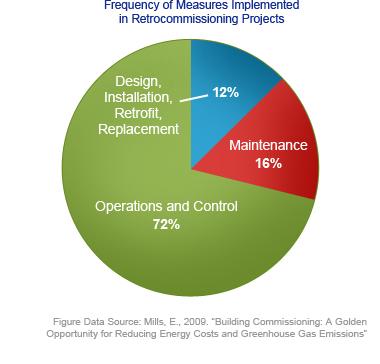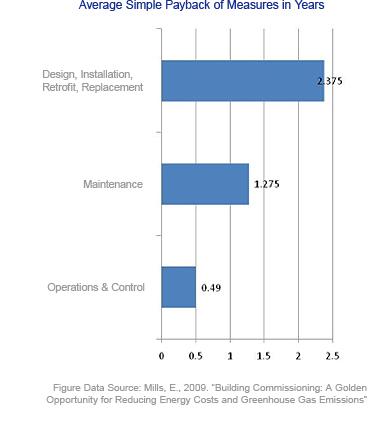Retro-Commissioning: Significant Savings at Minimal Cost Improving the Performance of Buildings through Retro-commissioning
25.7.2019
Retro-commissioning is a process to improve the efficiency of an existing building’s equipment and systems. It can often resolve problems that occurred during design or construction, or address problems that have developed throughout the building’s life as equipment has aged, or as building usage has changed. Retro-commissioning involves a systemic evaluation of opportunities to improve energy-using systems. If the same process were applied to a car, mechanics would make adjustments to the settings, controls, components and design of the engine based on how the owner actually drives.

The kinds of problems that retro-commissioning will identify and fix include:
- - Equipment or lighting that is on when it may not need to be
- - Systems that simultaneously heat and cool
- - Belts and valves that are not functioning properly
- - Thermostats and sensors that are out of calibration
- - Air balancing systems that are less than optimal
- - Economizers that are not working as designed
- - Controls sequences that are functioning incorrectly
- - Variable-frequency drives that operate at unnecessarily high speeds or that operate at a constant speed even though the load being served is variable
Many of these small operations and control improvements cost little or nothing to implement, yet some can have big effects. For example, sensor calibration not only improves current operations but also increases the effectiveness of diagnostic monitoring and testing.
Why is retro-commissioning important?
Commercial buildings frequently undergo operational and occupancy changes that challenge the mechanical, electrical and control systems, hindering optimal performance. In today’s complex buildings, systems are highly interactive, with sophisticated controls that can create a trickle-down effect on building operations – small problems have big effects on performance. All buildings can experience performance degradation over time.
The Pacific Northwest National Laboratory has proposed that operations and controls elements of the retro-commissioning process may be worth repeating with greater frequency than current practice dictates, given their low-cost and high energy savings potential, and the fact that building systems can quickly drift out of sync.

Costs and benefits
Retro-commissioning benefits everyone in a building. Building owners see reduced operating costs from the energy savings and better equipment performance, leading to an increase in net operating income. Building occupants are more comfortable because the adjustments lead to more consistent temperature control and better indoor air quality. Building managers, meanwhile, face fewer occupant complaints and are better able to manage building systems.
Retro-commissioning can produce significant cost savings in existing buildings. Savings vary depending on the building size, age and location, and the scope of the retro-commissioning process. Studies show that the costs of retro-commissioning activities range from $0.13 to $2.00 per square foot, while payback ranges from 0.2 to 2.1 years. Overall energy savings can reach approximately 15 percent. Of the different measures typically completed as part of retro- commissioning projects, correction of operations and control measures have the shortest paybacks, while maintenance measures have longer paybacks. Design, installation, retrofit and replacement of equipment have the longest paybacks (see figure).
Comparing persistence of retro- commissioning measures
When equipment is installed, repaired or retrofitted, the benefits of these physical upgrades tend to persist. In contrast, improvements in operations and controls strategies can be easily overridden, reprogrammed, or bypassed, so that the resulting comfort and energy savings benefits are less likely to persist over time. Items that may affect persistence include changes in occupancy levels or schedules, changes in space layouts, overriding of control logic or setpoints by staff or occupants to quickly fix problems, or replacement of systems or controls.
One study of persistence in retro-commissioning found that nearly every building examined had issues with persistence – energy savings decreased by 17 percent over two years. 4 The least durable fixes were control strategies like schedules and set points.
Another study on retro-commissioning identified specific measures that did not persist, for example, air distribution reset, cooling plant start/stop, and calibration strategies. 5 All of the identified strategies were related to operations and controls.
Retro-commissioning is a process worth considering on a periodic basis for any existing building, especially if the building’s configuration, functions, and usage patterns change significantly or often. Retro-commissioning is another valuable tool for facility managers looking to get the most performance and the greatest occupant comfort for the least cost.
Originally published May 2012; updated March 2013: http://buildingefficiencyinitiative.org/articles/retro-commissioning-significant-savings-minimal-cost
For more information or our Retro-Commissioning proposal for your building please contact:
JIŘÍ KUBIAS, Ing., ČKAIT, ASHRAE Member Partner,
Design Director
Telephone: +420 602 517 936
E-mail:

News
- 29.6.2022 LEED Platinum certification and WELL HS rating for a new landmark office building in Warsaw, Poland
- 23.11.2020 Air desinfection by UV-C as an anti-Covid measure
- 25.7.2019 Retro-Commissioning: Significant Savings at Minimal Cost Improving the Performance of Buildings through Retro-commissioning
- 25.7.2019 Employees are Happier, Healthier and More Productive in LEED Green Buildings
- 25.7.2019 Šárecký dvůr won the Best Residential Development award
- 25.7.2019 LEED Platinum certification for two new buildings in Pankrac, Prague
- 17.5.2018 TRIMARAN at Prague Pankrac sets sails
- 11.4.2018 ERA COMPANY HEADQUOTER IN PARDUBICE

News
- 29.6.2022 LEED Platinum certification and WELL HS rating for a new landmark office building in Warsaw, Poland
- 23.11.2020 Air desinfection by UV-C as an anti-Covid measure
- 25.7.2019 Retro-Commissioning: Significant Savings at Minimal Cost Improving the Performance of Buildings through Retro-commissioning
- 25.7.2019 Employees are Happier, Healthier and More Productive in LEED Green Buildings
- 25.7.2019 Šárecký dvůr won the Best Residential Development award
- 25.7.2019 LEED Platinum certification for two new buildings in Pankrac, Prague
- 17.5.2018 TRIMARAN at Prague Pankrac sets sails
- 11.4.2018 ERA COMPANY HEADQUOTER IN PARDUBICE










